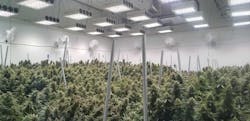Implement light mapping software from a plant perspective to improve cannabis grows (MAGAZINE)
One of the most critical aspects to consider when designing an indoor cannabis grow room is the correct placement of light fixtures to ensure the best lighting coverage possible. If done incorrectly, light can be inconsistent in intensity across the growing area or even unnecessarily wasted. Fortunately, there are software programs that can model light intensity throughout a room to generate a virtual map of light intensity. Most of these programs were written for use in architectural design for human lighting needs and have been repurposed for grow light modeling, often with no modifications to account for the different intended use.
While architectural light-mapping software can give a rough idea of light intensity variations in a room, there are some significant limitations. Human eyes are actually pretty poor at detecting slight differences in light intensity; our iris automatically contracts when exposed to brighter light levels, letting less light in and altering our perception of how intense the light really is. Architectural light-mapping software can therefore afford to be fairly “sloppy” in the way it calculates actual light intensity as our eyes won’t be able to tell the difference. Multiple shortcuts are employed by architectural lighting software to reduce the time it takes to generate a light map. But why is there a need for shortcuts? The answer lies in the way in which software factors in various values to arrive at light intensity.
How light is mapped
It helps to have a basic understanding of how the software actually works. To calculate the light intensity for a single spot in a room, you just need to know how much light that spot “sees” from every light fixture in a room. This is a simple calculation that takes into account the distance from the light source as well as the angle from the light to the spot being calculated. Light spreads out or diminishes in intensity the farther you get away from a light source, proportionate to the square of the distance. The angle is important because light fixtures usually try to direct the light where it is wanted, and thus even at the same distance from a light fixture there can be dramatically different light intensities. By knowing the absolute intensity (total flux) of a light fixture, the relative intensity a particular angle from the particular light fixture, and the distance from the light fixture, it is possible to easily calculate the intensity of light at any given spot that is coming directly from the fixture.
However, this doesn’t account for reflected light, which is a much larger component of light intensity than most people realize. To account for the reflected light in a four-walled room, light-mapping software has to calculate how much of the light will be reflected off of each of the four walls to the particular spot for which it is calculating the intensity. This is done by calculating how much light is hitting each wall from the light fixture, and then how much of that light will be reflected to the spot it is trying to model. Just adding four walls to the simulation has turned one simple calculation into nine — one for the light hitting the modeled spot directly from the fixture, one each for the light hitting the four walls at the appropriate spot to be angled to reflect light to the modeled spot, and then one each for those four walls to the modeled spot.
So for a “simple” four-walled room with one light fixture, it takes nine calculations to determine the light intensity at a given spot. If you add a second light fixture to the model, it takes 18 calculations per spot; 10 light fixtures takes 90 calculations per spot. If you add objects in the room that reflect or absorb light, you’re adding another two calculations per light fixture for each object. This algorithmic procedure is known as ray tracing, since you’re essentially tracing every ray of light from its source to a modeled spot.
Incidentally, this is how the highest-quality computer-generated imagery is made — ray-tracing all of the light sources across all of the modeled objects in a scene can yield remarkably detailed and life-like images. However, the number of calculations required increases dramatically with each light source and each object in the scene being modeled, to the point where it can take computers hours or days to render a single image.
Architectural light-mapping software can take advantage of many simplifying assumptions to generate a light intensity map much faster. Instead of modeling every square inch of a room, most will just model sample spots every few feet and then make assumptions about the spots in between as being intermediate values — a single averaging calculation instead of hundreds or thousands of calculations for each spot. Since human eyes aren’t very precise at all in determining actual light intensity, these simplifications are good enough for generating an architectural light map. This can reduce the time taken to generate a light map from hours to a few seconds, depending on the sampling rate.
Another inaccuracy in architectural light mapping software comes from the information the software has about the relative intensity of light at different angles from the fixture. The Illuminating Engineering Society (IES) came up with a standard file format for storing information about light fixture intensity and relative intensity at different angles; these IES files are fed into architectural light mapping software to be able to model different light fixtures. IES files are generated by testing facilities that put a light fixture on a rig that rotates (or rotates around the fixture itself) and measures the light intensity at various angles. For small devices under test (DUTs), such as a single LED, these test rigs are easily able to quickly measure intensity at a large number of different angles. For larger fixtures, such as most LED grow lights, the testing rig gets very expensive as it has to be quite large. Instead of measuring the light intensity at every degree of rotation, it is vastly cheaper to measure at only a few angles. The larger the light fixture, the more accurate the test and the resulting IES file, the more expensive it becomes. Most LED grow light fixtures are relatively large and therefore expensive to model accurately using this method.
If an IES file only has measurements from a few angles, architectural light mapping software has to make more assumptions as to what the actual relative light intensity will be at angles that are not included in the IES file, usually by simply taking a weighted average between the closest two angles included in the IES file.
Solving plant problems
Combining the sparse angle sampling in IES files and sparse spatial sampling by the model itself can lead to significant deviations between the model and reality. Again, for human eyes that may not even be able to distinguish a 10% difference in light intensity, this is not an issue- but for plants in a grow room these deviations can have a significant impact. Hot spots in a grow room can stress plants and reduce yield, while areas with lower-than-desired light levels can also reduce yield.
Cannabis plants have different minimum light requirements at different stages of growth, and maximum light levels vary depending on strain. Utilizing light-mapping models to precisely determine the type, number, and exact placement and height of light fixtures to ensure optimal light levels throughout the canopy can ensure that all plants receive ideal illumination. Accurate light modeling can also help drive grow room layout to optimize light utilization, minimizing wasted space and maximizing available canopy area.
Black Dog LED has developed its own grow room light-mapping software to eliminate these issues. Instead of utilizing sparsely-sampled angular test information, the software takes the angular intensity test information for each LED employed in our fixtures to accurately model angular intensity at every degree. The software also models every spot — down to every single square inch — rather than using sparse spatial sampling and averaging the readings in between. This allows us to much more accurately model a grow room’s lighting, identifying potential hot spots and dark spots that may never show up on a light map generated by architectural lighting software.
Plants have different spectral and light intensity needs than human eyes; why use software designed for human eyes’ needs to model your plant grow room?
EDITOR’S NOTE
Get the big picture of horticultural needs
Tools like software are just starting to make inroads with agriculture and horticulture. As technology providers raise their value proposition to a new generation of growers and farmers, other fundamental discussions with end users would include the relationship between energy efficiency, yields, and return on investment when it comes to properly specifying fixtures. Customizing LED light recipes and designing fixtures to achieve optimal plant responses remains a point of interest. At HortiCann Light + Tech in 2019, Frender discussed spectral impacts on cannabis growth characteristics and yields. You can find a preview of the themes and trends that will be discussed at this year’s virtual conference in this issue. HortiCann Light + Tech will be held Oct. 20‒21, 2020. Find more information and register for sessions on the event web page.
Get to know our expert
KEVIN FRENDER is chief science and technology officer of Black Dog LED. With 7 years of experience at the company, and 35 years’ experience as an indoor grower, he has cultivated a vast knowledge base of artificial lighting technologies.
For up-to-the-minute LED and SSL updates, why not follow us on Twitter? You’ll find curated content and commentary, as well as information on industry events, webcasts, and surveys on our LinkedIn Company Page and our Facebook page.







